It’s very important to use the right type of soil for container gardening so your plants can grow their best. Outdoor potted plants need a medium that is well-draining, porous, moisture retentive, and rich with nutrients.
Things like cheap fill dirt, topsoil, and garden soil are not good to use in pots. In this post, I’ll tell you exactly what to look for in a quality soil mix for your containers.
I will also talk about the different types, show you which ones to avoid, and I’ve even included my favorite recipes with steps for how to make your own.
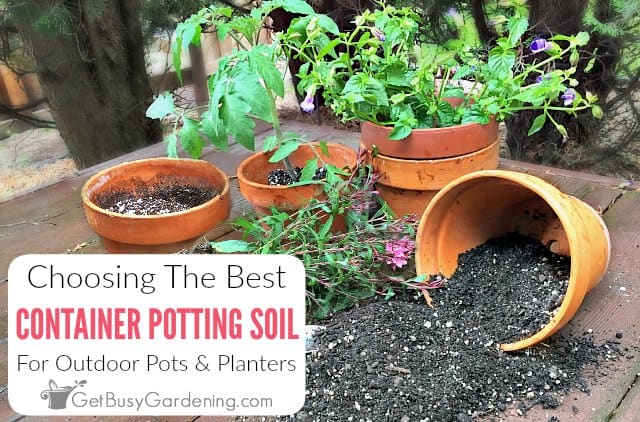
What Is The Best Soil For Container Gardening?
A good quality, all-purpose soil mix that’s specifically made for outdoor containers is usually the best option. You can make your own with my recipe below, or buy it from the store.
But if you’ve ever walked down the soil aisle at your local garden center or home improvement store, you know that there are tons of options to choose from.
So how do you know which one is best for container gardening? That’s easy, simply read the label to look for these traits:
- Light & airy – The medium should be light and fluffy, which allows for plenty of air to reach the roots.
- Well-draining – Container potting soil should always have good drainage so it doesn’t become soggy or saturated.
- Porous mix – It should also be porous, so that water and air can easily get to the roots of the plant.
- Loamy, nutrient rich – Plants need a rich, fertile soil to grow and thrive, so make sure the one you choose contains plenty of organic materials (and avoid ones with chemical fertilizers).
- Moisture retentive – Since potted plants tend to dry out faster during the summer, the mix should hold moisture.
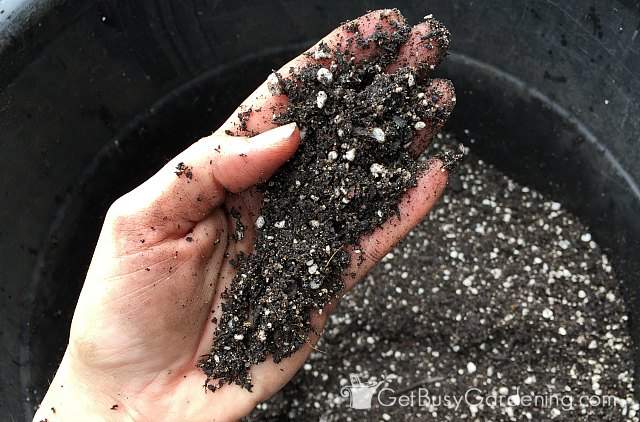
Soils & Ingredients To Avoid
I get asked all the time about using different types of soil or dirt for container gardening, and I’ve learned from experience what works and what does not. So please avoid making these common mistakes:
- Garden soil – You should never use garden soil in your pots because it is too heavy and will quickly become compacted. Plus it’s not clean, so it can contain bugs, mold spores, disease pathogens, weed seeds, and other nasty organisms.
- Topsoil or fill – I know it’s much less expensive, but do not make the mistake of using topsoil or fill dirt in your containers. These are cheaper for a reason – because they don’t have any nutrients, and they’re usually filled with rocks and dirt.
- Compost only – While you can add it to your container potting soil, using compost alone is not a good idea. It’s best to use a mix which contains other ingredients to prevent compaction, and improve aeration and drainage.
- Manure – You can mix manure into your containers, BUT only if it’s well composted. Fresh manure is too strong and can burn the roots of your plants. It can also contain pathogens that could harm your plants, or make you sick. Plus, it probably won’t smell very good.
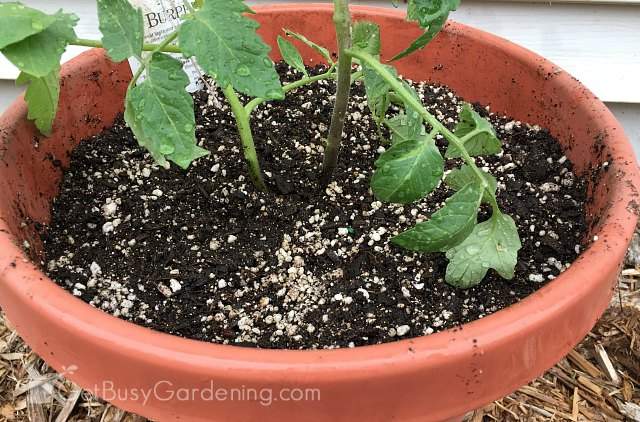
How To Make Potting Mix For Container Gardening
Below, I’ve included 2 DIY container soil recipes. The first is a general mix to use for pots that will be sitting on the ground or other sturdy surface, and the second is a soilless mix for hanging baskets and planters.
It’s amazing how heavy a pot will become once it’s filled with moist soil. So, make sure to choose the right mix for each of your containers:
1. General Container Soil Mix Recipe
This general recipe is great for using in containers that sit on the ground or on a sturdy base. Since the compost makes the soil much heavier, it’s not ideal for hanging pots.
- 2 parts peat moss, coco coir (pre-moistened), or potting soil
- 2 parts compost, composted manure, or worm castings
- 1 part perlite
- ¼-½ parts vermiculite
- 1 Tablespoon garden lime per gallon (if you use peat moss)
2. Soilless Mix Recipe
My soilless container potting mix recipe is much lighter. So it’s perfect to use in any type of hanging baskets or planter boxes.
- 2 parts peat moss or coco coir (pre-moistened)
- 1 part perlite
- ¼-½ parts vermiculite
- 1 Tablespoon garden lime per gallon (if you use peat moss)
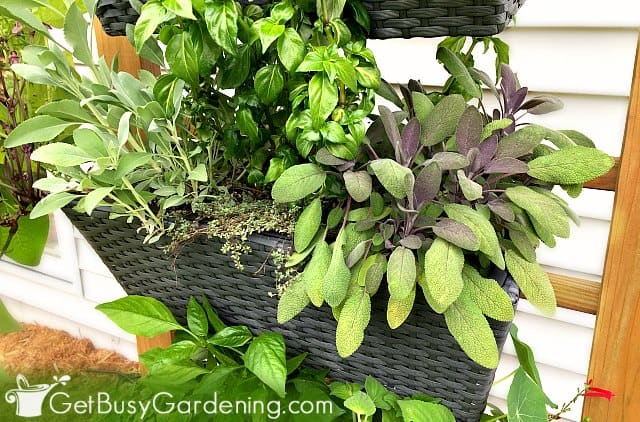
Ingredients & Substitutions
Below is a breakdown describing each ingredient and what it adds to the mix, as well as any substitutions you can make.
- Peat moss or coco coir – These two are interchangeable. They’re great for water retention and aeration. You can use a general purpose mix instead, if you have that on hand.
- Compost – This is an easy and natural way to add important nutrients and beneficial organisms into your DIY container potting soil. It also helps to retain moisture. You can substitute with well-composted manure or worm castings.
- Perlite – This is a natural ingredient that prevents soil compaction and adds aeration and drainage. You can use pumice instead if that’s easier to find where you live.
- Vermiculite – This helps the soil retain moisture, keeps the mix light and fluffy, improves drainage, and prevents compaction.
- Garden lime – You only need to add this if you’re using peat moss, because it’s acidic. So, if your plants like alkaline soil, then you’ll need to also add lime to your mix to balance out the acidity to a neutral pH level.
Step By Step Instructions
Supplies Needed:
- Measuring container (I use a 1 gallon bucket, but you can use a soil scoop, a hand trowel, or something similar)
- Shovel
- Soil scoop
- Large garden tub or wheelbarrow (for mixing)
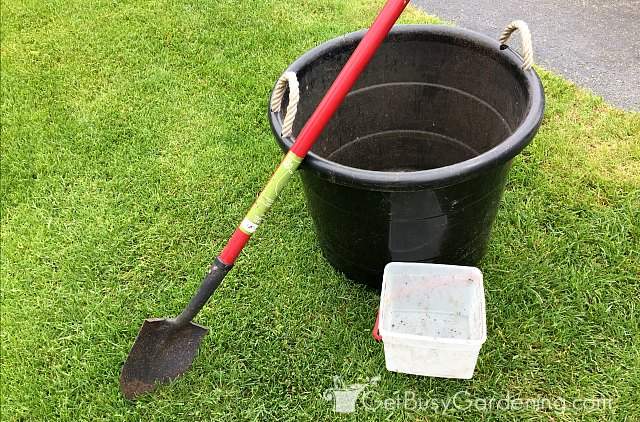
Step 1: Gather your supplies – Taking the time to gather and prepare all of your ingredients, tools, and supplies beforehand will speed things up. Make sure your mixing container (I use a large garden tub) and your shovel are both clean and dry.
Note: You can use a 1 gallon bucket, soil scoop, or a trowel to measure each part. It doesn’t matter what you use, just make sure it’s the same size for each of your ingredients.
Step 2: Measure the base ingredient(s) – If you’re making the basic container mix recipe, then add equal parts of peat moss, coco coir, OR potting soil AND the compost (don’t use potting soil or compost for the soilless mix). Pour them into your mixing container, and stir everything together until well combined.
Step 3: Add everything else – Pour the perlite, vermiculite, and garden lime (if using peat moss) into your mixing container. If your ingredients are super dry, then add a little water to moisten them.
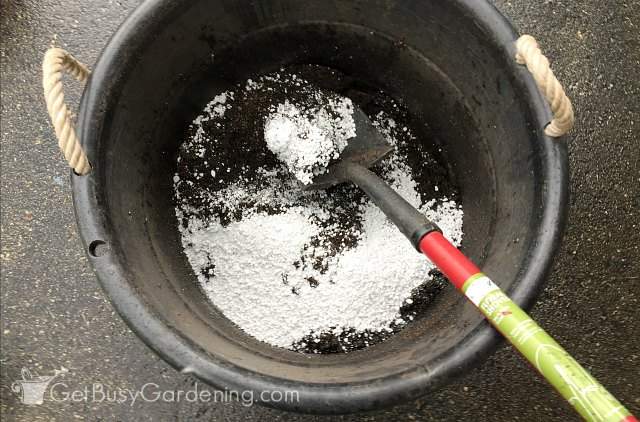
Step 4: Mix well – Stir everything together thoroughly. You want to avoid large pockets of ingredients, so make sure to mix it well during this step. If your DIY container potting soil is too dense or thick for your liking, add more perlite until it feels right.
Step 5: Use it now or store it for later – You can use it to fill your containers right away, or store it for later so you always have some on hand.
Related Post: How To Fertilize Outdoor Potted Plants & Containers
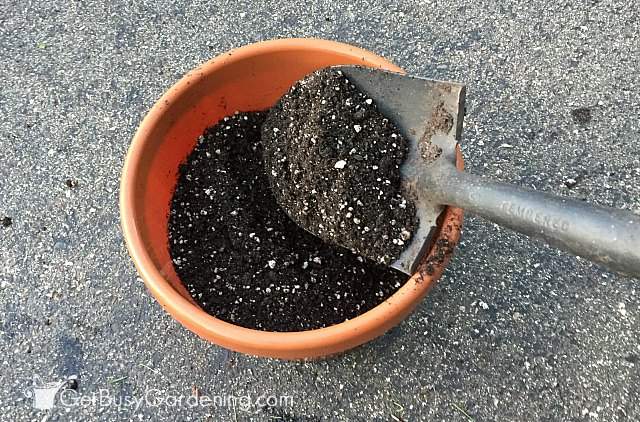
Storing Your Leftover Container Soil
To save your unused soil, simply store it in an airtight container and keep it in your garage or a shed.
I store mine in a five gallon bucket with a tight fitting lid. Whatever you use, just make sure it has an airtight lid to prevent bugs and pathogens from getting in there.
Related Post: 7 Easy DIY Potting Soil Recipes To Mix Your Own
How Often To Change The Soil In Your Containers
How often you need to replace the soil in your outdoor pots depends on what you’re growing, and the size of your container.
For annual flowers and vegetables, it’s best to start with fresh potting soil every year. This is especially important if you’ve had any issues with bugs or diseases.
If you have extremely large and deep containers, then you don’t need to replace all of the soil. In this case, I recommend refreshing the top 5-10 inches with fresh soil before you plant anything new in there.
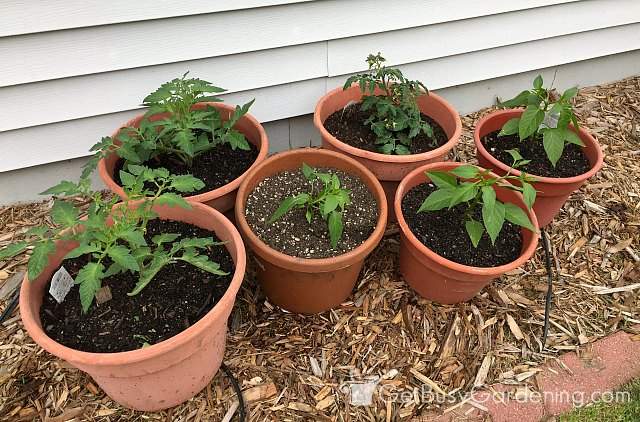
Using the best soil for containers is important to grow beautiful and healthy plants. So always check the package to find the perfect one, or make your own so you can control the ingredients.
More About Potting Soils
- How To Make Potting Soil For Indoor Plants
- How To Make Succulent Potting Soil
- How To Make Your Own Cactus Soil Mix
- How To Make DIY Seed Starting Mix
More Container Gardening Posts
- Container Gardening Design Tips & Ideas
- How To Clean Terracotta Pots (In 3 Easy Steps!)
- How To Install A DIY Drip Irrigation System For Potted Plants
Share your tips for choosing the best potting soil for container gardening or your favorite recipe in the comments section below.
Printable Step By Step Instructions
Container Garden Soil Mix Recipes

Making your own container potting soil is easy and frugal. Learn how to make it step-by-step with my 2 simple recipes.
Instructions
General Container Soil Recipe:
- 2 parts peat moss or coco coir
- 2 parts compost
- 1 part perlite
- ¼-½ parts vermiculite
- 1 Tablespoon garden lime per gallon (if you use peat moss)
Soilless Mix For Hanging Pots:
- 2 parts peat moss or coco coir
- 1 part perlite
- ¼-½ parts vermiculite
- 1 Tablespoon garden lime per gallon (if you use peat moss)
Mixing Instructions
- Gather your supplies - Before getting started, make sure your tools and your mixing container are clean and dry.
- Measure the base ingredient(s) - If you’re making the basic container soil, then measure out the peat moss OR coco coir AND the compost and pour them into your large garden tub. Then use your shovel to stir everything together until well combined. Skip this step for the soilless mix.
- Add everything else - Add the perlite, vermiculite, and garden lime (if using peat moss) into your mixing container.
- Mix well - Stir everything together thoroughly until all pockets of the ingredients are fully combined. If the mix is too dense or thick for your liking, add more perlite until it feels right.
- Use it or store it for later - You can use your DIY potting soil to fill your containers right away, or store it for later so you always have some on hand.
Notes
- Use the general soil recipe for pots that will be sitting on the ground or a sturdy surface, and the soilless mix for hanging baskets and planters.
- You can use a 1 gallon bucket, soil scoop, or a trowel to measure each part. It doesn’t matter what you use, just make sure it’s the same size for each of your ingredients.
- Store the leftovers in a bucket with a tight-fitting lid, and keep it in a cool, dry location.


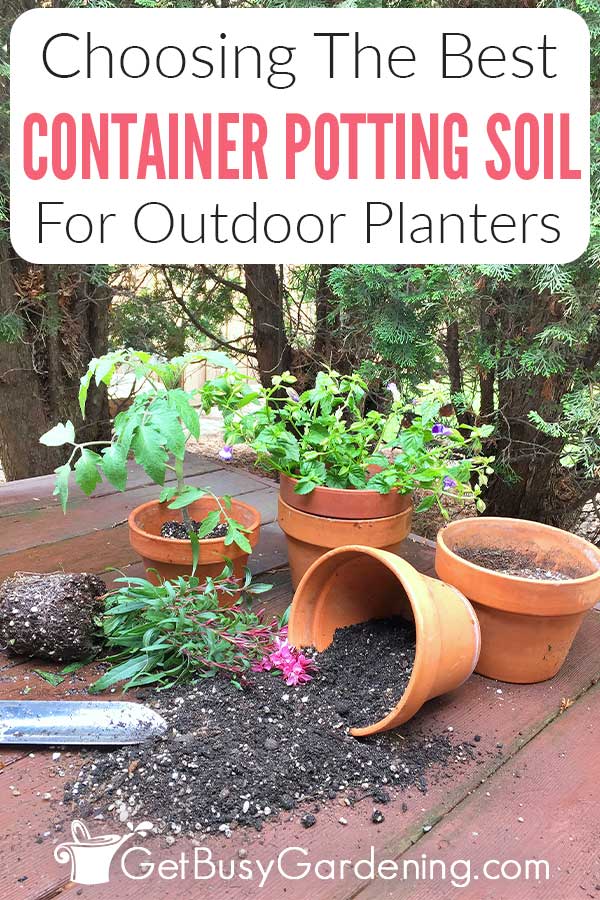
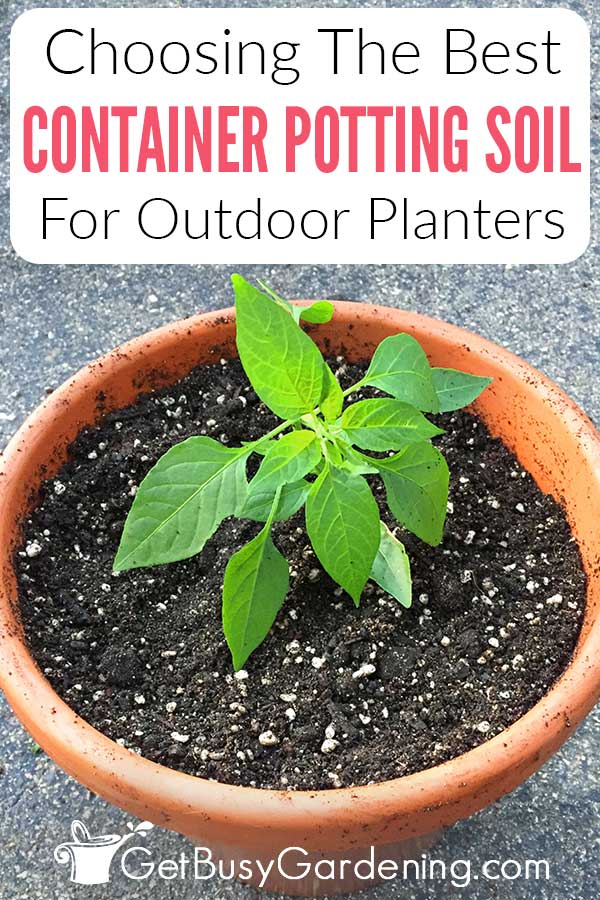
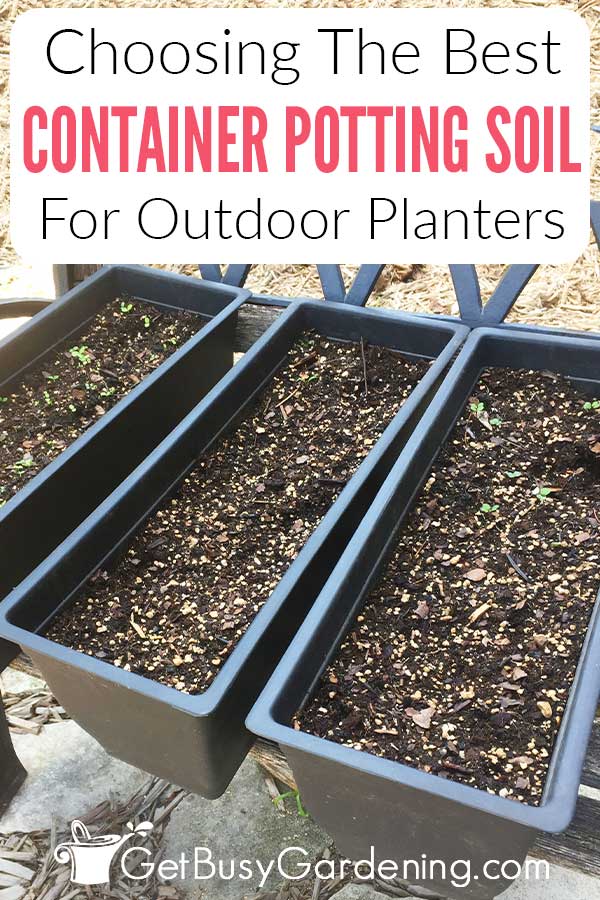



Terry Jeffrey says
We had a fenced off area for chickens last year and after they were killed by raccoons we decided not to get any more. We are taking the fencing down and wondering what is the best way to use that soil? Can we mix it into our raised beds and containers that we are planning for this year?
Amy Andrychowicz says
You could use it in your raised beds, but I don’t recommend using soil from the ground in your containers or it could cause compaction.
Paul Holmes says
I grow tomatoes in 10gal. grow bags. I use 60% top soil 20%compost and 20%peat moss. Tomatoes grow like crazy with this mix. and it retains water better than all those lite mixes. Don’t have to water as much.
Amy Andrychowicz says
Awesome, thanks for sharing the potting soil recipe you use for your containers!
Barbara says
Is it safe to use Viva soil, which is meant for problem grass?
Amy Andrychowicz says
I’m not familiar with that specific product. But it’s best to use a potting soil that is specifically designed for containers, as soil made for a lawn is likely going to be too heavy to use for potted plants.
Steve O. says
It sounds like your recipe calls for dry measurement of peat moss but if you use coco coir it has to be wet first as it comes in blocks. I think there would be a huge difference in volume between dry peat moss and wet coir. Any suggestions, I need to make at least a couple of wheelbarrows full soon for tomatoes in 5 or 10 gallon containers, I’m new to container planting but have experience with raised beds for veggies,
Thanks for any suggestions
Amy Andrychowicz says
Yes, you should moisten the peat moss first.
mehdi hashemi says
Hello
How are you
Can i use of this recipes to indoor plant?
Or can i use compost in indoor soilless potting mix?
Thanks
Amy Andrychowicz says
No, this potting soil recipe is for outdoor containers only. You should use my houseplant potting soil recipe for your indoor plants instead.
Nayana says
Last two years I used garden soil for my vege pots. I was wonder why i didnt get result . Now I know.tjanks
Amy Andrychowicz says
Oh no! Don’t feel bad, that is a very common mistake. I hope your veggie containers will grow much better for you now that you know the best type of soil to use for them. Good luck!
Nana Akua says
I live in west Africa, l use garden soil for almost all my plants in containers it grow so well because our soil is fertile rich in organic materials. I haven’t encountered any problems so far.
Amy Andrychowicz says
Glad to hear you haven’t had any problems using the soil from your garden in your outdoor pots. However, I do not recommend doing so because it can cause major problems, as I mentioned in the article. Thanks for sharing your experience though. 🙂
Laudon fourie says
I bought raised bed soil instead of potting soil will that still work or should I just return it and start over
Amy Andrychowicz says
Raised bed soil is meant for gardens, and it’s too heavy for using in containers. I would either return it, and buy container potting soil instead. Or, you could use it as the base for mixing your own using my recipe above.
Tracy Brothers says
Hi! I have 2 new elevated (bad back) garden beds 12” deep each needing 29sqft of soil. I was going to use your soilless recipe (minus compost) but wanted to understand, why no compost? What to add How much to add nutrient wise instead?
Amy Andrychowicz says
You can definitely use compost in your raised beds. The recipe for the soilless mix is for outdoor pots and containers that aren’t sitting on the ground, like hanging baskets for example. Compost adds a lot of weight to the mix, and that’s why the soilless mix is better for hanging planters, since it’s lighter. You don’t have to worry about weight for raised beds, so adding compost will be just fine. Hope that makes sense.
jackie says
What potting soil do you recommend for food crops? I want to do containers with herbs, tomatoes blueberries and strawberries and want to get the soil right.
Amy Andrychowicz says
The ones you’re asking about require different types of soil. The best container soil for herbs and veggies would be a rich alkaline mix, where berries require acidic soil in order to grow and produce fruit. I have recipes that you can use for each of them, so take a look at this list of DIY potting soil recipes, and search for the “Vegetables & Herbs Mix” and the “Acidic Potting Soil”.
JoAnne says
We have some big container gardens that we plan on growing tomatoes in. Last year was a bust. All of our tomatoes had black bottoms – not good at all. I’m thinking about trying your homemade organic soil mix this year. Do you think it will work in these large containers, or should we make some alterations to the container potting soil recipe?
Amy Andrychowicz says
No alterations necessary, the container potting mix recipe will work great in any size pot. However, if you’re struggling with blossom end rot, then it’s most likely due to inconstant watering. I recommend installing a simple drip irrigation system in your pots to make it super easy to give them the perfect amount of water, and help to prevent blossom end rot.
Pepper says
Hi,
Could I leave out the vermiculite from the recipe, so long as I include the perlite?…… would it make much of a difference? Also, could you start seeds in this mix?
Amy Andrychowicz says
Yes, you could leave the vermiculite out of either recipe. But without it, the soil will likely dry out much faster (vermiculite helps the soil retain moisture, perlite is for adding drainage). I would not recommend this container potting soil recipe for starting seeds. Use my DIY seed starting mix recipe instead.
Tim P. says
I’m so glad I found your post. I’ve been trying to grow vegetables in grow bag containers for a couple of summers with mixed results. I am definitely going to try your container potting soil recipe. Thanks!
Amy Andrychowicz says
Great, I’m glad I could help you out! I hope my container potting soil recipe works well for you this year!
Natalya says
What type of potting mix would you use to grow small shrub in containers, like black currant? Thanks
Amy Andrychowicz says
I would recommend mixing all-purpose container potting soil with a good quality compost at a 50/50 mix, and then adding in some sand and perlite for extra drainage.
iv says
I truly can use this post, because Ive been thinking about starting a small container garden. It’s good to know about the different types of soil to use, I had no idea soil would make such a big difference! Happy weekend!
Amy Andrychowicz says
Wonderful, glad I could help! Good luck starting your new container garden, and enjoy!
Ivory says
Wow, thanks for explaining all about the types of soil I can use in my containers! I am so on this. Thank you.
Amy Andrychowicz says
Awesome! You’re welcome. 🙂